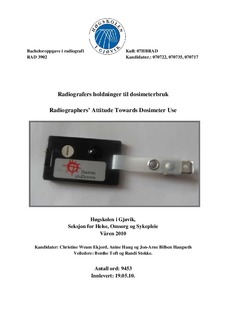| dc.description.abstract | Introduction The subject of this bachelor’s thesis is radiographers’ use and attitudes towards the dosimeter in relation to guidelines and regulations. The background for the choice of subject is that we have observed radiographers using dosimeters in different ways. This led us to want to examine how radiographers view the correct use of the dosimeter in relation to existing guidelines and regulations. We have chosen to compare conditions in Norway with Namibia. We felt that it would be interesting to compare an international occupation in two different continents, where Norway is a country that is relatively rich in resources compared to Namibia. Is emphasis on the use of dosimeters as strong in Namibia as in Norway? Our problem: ”Do radiographers' use of dosimeters comply with the regulations and guidelines from the Radiation Protection Authority, and what are the attitudes of radiographers towards using dosimeters?”
Methodology This thesis takes a qualitative approach. We chose to gather information using semi-structured interviews. An interview guide was used as a template and the interviews were recorded as audio files. A strategic selection of informants was carried out, where three radiographers were selected at a hospital in Norway, and three at a hospital in Namibia. By using this approach we wanted to gain a better understanding of the informants’ attitudes towards and use of dosimeters.
Results All of the six informants want to use dosimeters on a daily basis for various reasons. In Namibia conditions are somewhat poorer than in Norway, and dosimeters are not so readily available. The radiographers demonstrated different attitudes towards and knowledge on the use of dosimeters. In Norway there are guidelines and regulations for the use of the dosimeter, but we have been unable to find such in Namibia. All of the informants recognize the benefits of using dosimeters, and all use them correctly. The informants displayed little knowledge of the guidelines and regulations concerning the use of dosimeters.
Discussion We see that the informants wear dosimeters correctly, but we don’t believe that this is due to knowledge of guidelines and regulations for dosimeters. This is due to the fact that the interviews reveal a general lack of knowledge concerning regulations and guidelines. We believe that the Namibian informants display a greater interest in the use of dosimeters than the Norwegian informants, despite a poorly functioning dosimetry service in Namibia. We recognize that Norway has a well-functioning dosimetry service, but that the informants display less interest in checking the dosimeter readings. | en_US |
